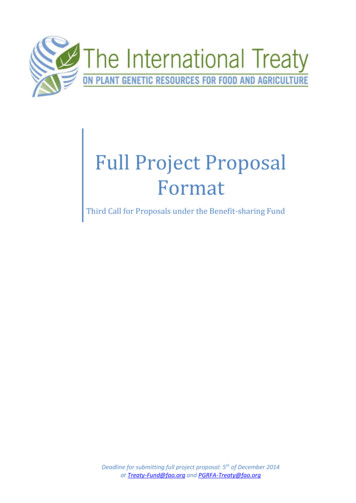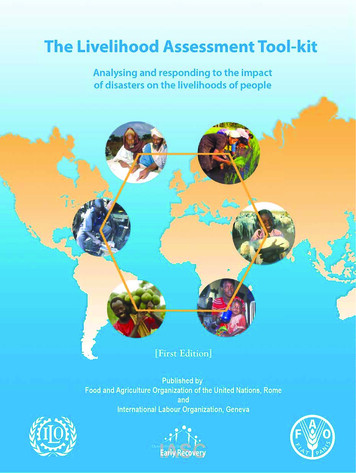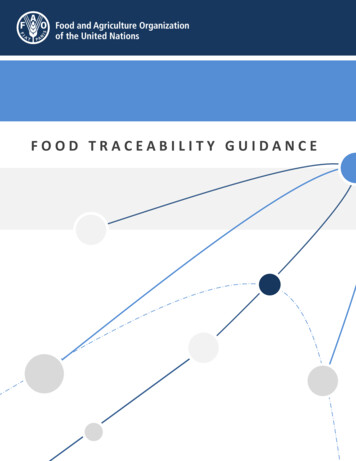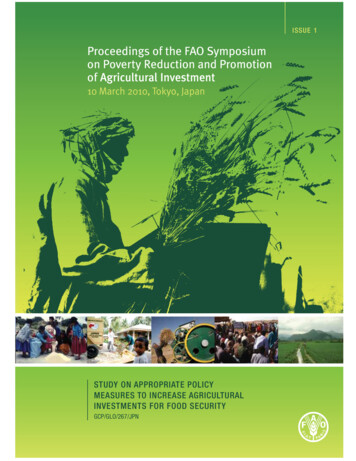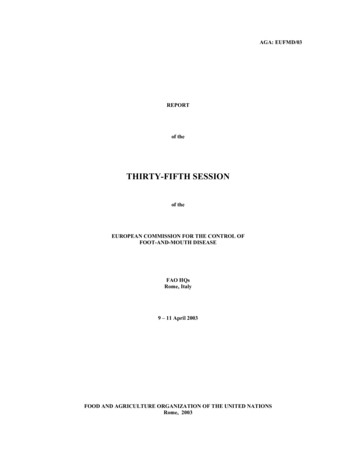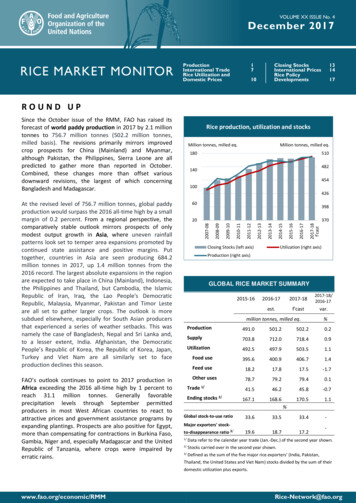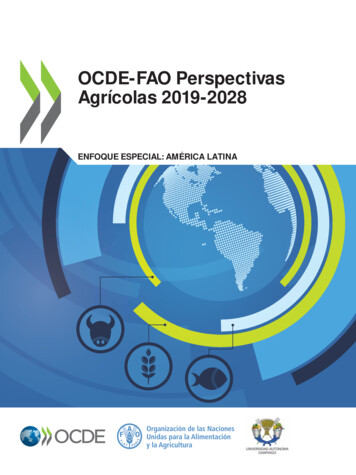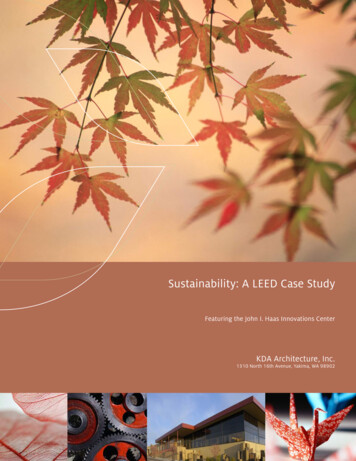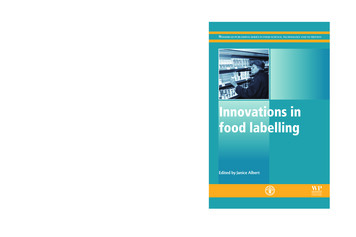
Transcription
WOODHEAD PUBLISHING SERIES IN FOOD SCIENCE, TECHNOLOGY AND NUTRITIONWOODHEAD PUBLISHING SERIES IN FOOD SCIENCE, TECHNOLOGY AND NUTRITION
Innovations in food labelling
Related titles:EU food law(ISBN 978-1-85573-557-6)This book is an ideal introduction to this complex field for the non-specialist. The bookopens with an introduction to the key principles of EU food law and the main mechanismsof enforcement. The following chapters cover legislation in specific areas including hygiene,additives and functional foods.Food labelling(ISBN 978-1-85573-496-8)J Ralph Blanchfield has brought together a distinguished panel of European and Americanexperts from industry and academia. Together they provide a comprehensive guide toproducing labelling that complies with existing legislation and satisfies the needs of allinterested parties. Food labelling also provides a valuable insight into possible futuredevelopments.Understanding consumers of food products(ISBN 978-1-84569-009-0)It is very important for food businesses, scientists and policy makers to understandconsumers of food products: in the case of businesses to develop successful products and inthe case of policy makers to gain and retain consumer confidence. Consumers’ requirementsand desires are affected by issues such as culture, age and gender and issues important toconsumers nowadays such as diet and health or GM foods will not always be so significant.Therefore food businesses and policy makers need to understand consumers’ attitudes andthe influences upon them to respond effectively. Edited by two distinguished experts, thisbook is an essential guide for food businesses, food scientists and policy makers.Details of these books and a complete list of titles from Woodhead Publishing can beobtained by: visiting our web site at www.woodheadpublishing.com contacting Customer Services (e-mail: sales@woodheadpublishing.com; fax: 44 (0)1223 832819; tel.: 44 (0) 1223 499140 ext. 130; address: Woodhead PublishingLimited, 80 High Street, Sawston, Cambridge CB22 3HJ, UK) contacting our US office (e-mail: usmarketing@woodheadpublishing.com; tel.: (215)928 9112; address: Woodhead Publishing, 1518 Walnut Street, Suite 1100,Philadelphia, PA 19102-3406, USA)
Innovations infood labellingEdited byJanice AlbertPublished byThe Food and Agriculture Organizationof the United NationsandWoodhead Publishing LimitedOxford Cambridge Philadelphia New Delhi
Published by The Food and Agriculture Organization of the United Nations andWoodhead Publishing LimitedWoodhead Publishing Limited, 80 High Street, Sawston, Cambridge CB22 3HJ, UKwww.woodheadpublishing.com; www. woodheadpublishingonline.comWoodhead Publishing, 1518 Walnut Street, Suite 1100, Philadelphia, PA 19102-3406, USAWoodhead Publishing India Private Limited, G-2, Vardaan House, 7/28 Ansari Road,Daryaganj, New Delhi – 110002, Indiawww.woodheadpublishingindia.comFirst published 2010, Woodhead Publishing Limited FAO, 2010 except Chapter 5 which is Crown copyright, 2010The authors have asserted their moral rights.The designations employed and the presentation of material in this publication do notimply the expression of any opinion whatsoever on the part of the Food and AgricultureOrganization of the United Nations concerning the legal status of any country, territory,city or area of its authorities, or concerning the delimitation of its frontiers or boundaries.The mention of specific companies or products of manufacturers, whether or not thesehave been patented, does not imply that these have been endorsed or recommended byFAO in preference to others of a similar nature that are not mentioned. The viewsexpressed herein are those of the authors and do not necessarily represent those of FAO.All rights reserved. Reproduction and dissemination of material in this informationproduct for educational or other non-commercial purposes are authorized without anyprior written permission from the copyright holders provided the source is fully acknowledged. Reproduction of material in this information product for resale or othercommercial purposes is prohibited without written permission of the copyright holders.Application for such permission should be addressed to the Chief, Electronic PublishingPolicy and Support Branch, Communication Division, FAO, Viale delle Terme diCaracalla, 00100 Rome, Italy or by e-mail to copyright@fao.org.British Library Cataloguing in Publication DataA catalogue record for this book is available from the British Library.Woodhead Publishing ISBN 978-1-84569-676-4 (print)Woodhead Publishing ISBN 978-1-84569-759-4 (online)ISSN 2042-8049 Woodhead Publishing Series in Food Science, Technology and Nutrition (print)ISSN 2042-8057 Woodhead Publishing Series in Food Science, Technology and Nutrition (online)FAO ISBN 978-92-5-106180-0 - E-ISBN 978-92-5-107768-9 (PDF)The publisher’s policy is to use permanent paper from mills that operate a sustainableforestry policy, and which has been manufactured from pulp which is processed using acidfree and elemental chlorine-free practices. Furthermore, the publisher ensures that the textpaper and cover board used have met acceptable environmental accreditation standards.Typeset by Ann Buchan (Typesetters), Middlesex, UKFront cover image FAO/Roberto Faidutti
ContentsForeword . . . . . . . . . . . . . . . . . . . . . . . . . . . . . . . . . . . . . . . . . . . . . . . . . . . . . ix12Introduction to innovations in food labelling . . . . . . . . . . . . . . . . . . . .Janice Albert, Food and Agricultural Organization of the UnitedNations (FAO), Italy1.1Introduction: the evolution of food labelling . . . . . . . . . . . . . . . . .1.2Standards and legal issues . . . . . . . . . . . . . . . . . . . . . . . . . . . . . . . .1.3Labelling to protect and promote health . . . . . . . . . . . . . . . . . . . . .1.4Labelling to protect the environment and promote sustainablefood production . . . . . . . . . . . . . . . . . . . . . . . . . . . . . . . . . . . . . . . .1.5Labelling to promote social well-being and protect culture . . . . . .1.6Labelling in relation to new technologies . . . . . . . . . . . . . . . . . . . .1123344The Codex Alimentarius and Food Labelling: delivering consumerprotection . . . . . . . . . . . . . . . . . . . . . . . . . . . . . . . . . . . . . . . . . . . . . . . . . . 5Alan W. Randell, former Secretary of the Codex AlimentariusCommission, Italy2.1Introduction . . . . . . . . . . . . . . . . . . . . . . . . . . . . . . . . . . . . . . . . . . . 52.2The Codex framework for food labelling . . . . . . . . . . . . . . . . . . . . 62.3Specific food labelling issues in the Codex general standard . . . . . 72.4Claims and other interpretative guidelines . . . . . . . . . . . . . . . . . . . 92.5Nutrition labelling: health and nutrition claims . . . . . . . . . . . . . . 102.6Labelling, food safety and allergens . . . . . . . . . . . . . . . . . . . . . . . 122.7Foods derived from biotechnology . . . . . . . . . . . . . . . . . . . . . . . . 132.8Codex, labelling and advertising . . . . . . . . . . . . . . . . . . . . . . . . . . 132.9Conclusions . . . . . . . . . . . . . . . . . . . . . . . . . . . . . . . . . . . . . . . . . . 142.10 References . . . . . . . . . . . . . . . . . . . . . . . . . . . . . . . . . . . . . . . . . . . 15
viContents3International legal frameworks for food labelling and consumerrights . . . . . . . . . . . . . . . . . . . . . . . . . . . . . . . . . . . . . . . . . . . . . . . . . . . .Margret Vidar, Food and Agriculture Organization of the UnitedNations (FAO), Italy3.1Introduction . . . . . . . . . . . . . . . . . . . . . . . . . . . . . . . . . . . . . . . . . .3.2International human rights law . . . . . . . . . . . . . . . . . . . . . . . . . . .3.3Consumer protection . . . . . . . . . . . . . . . . . . . . . . . . . . . . . . . . . . .3.4International trade agreements . . . . . . . . . . . . . . . . . . . . . . . . . . .3.5Conclusions . . . . . . . . . . . . . . . . . . . . . . . . . . . . . . . . . . . . . . . . . .3.6Acknowledgement . . . . . . . . . . . . . . . . . . . . . . . . . . . . . . . . . . . . .3.7References . . . . . . . . . . . . . . . . . . . . . . . . . . . . . . . . . . . . . . . . . . .456Government and voluntary policies on nutrition labelling: a globaloverview . . . . . . . . . . . . . . . . . . . . . . . . . . . . . . . . . . . . . . . . . . . . . . . . . .Corinna Hawkes, Independent Consultant, Food and NutritionPolicy, France4.1Introduction . . . . . . . . . . . . . . . . . . . . . . . . . . . . . . . . . . . . . . . . . .4.2Nutrition facts tables . . . . . . . . . . . . . . . . . . . . . . . . . . . . . . . . . . .4.3Graphical nutrition labelling . . . . . . . . . . . . . . . . . . . . . . . . . . . . .4.4Trends . . . . . . . . . . . . . . . . . . . . . . . . . . . . . . . . . . . . . . . . . . . . . .4.5Conclusions . . . . . . . . . . . . . . . . . . . . . . . . . . . . . . . . . . . . . . . . . .4.6References . . . . . . . . . . . . . . . . . . . . . . . . . . . . . . . . . . . . . . . . . . .Labelling of allergenic foods of concern in Europe . . . . . . . . . . . . . . .Sue Hattersley and Chun-Han Chan, Food Standards Agency,United Kingdom5.1Introduction . . . . . . . . . . . . . . . . . . . . . . . . . . . . . . . . . . . . . . . . . .5.2Drivers behind the development of specific EU allergenlabelling legislation . . . . . . . . . . . . . . . . . . . . . . . . . . . . . . . . . . . .5.3Exemptions for certain processed ingredients derived from thespecified allergenic foods . . . . . . . . . . . . . . . . . . . . . . . . . . . . . . .5.4Other allergen information that manufacturers can choose toput on food packaging . . . . . . . . . . . . . . . . . . . . . . . . . . . . . . . . . .5.5Possible legislative developments in the future, including foodssold non-prepacked . . . . . . . . . . . . . . . . . . . . . . . . . . . . . . . . . . . .5.6Foods sold as ‘free from’ . . . . . . . . . . . . . . . . . . . . . . . . . . . . . . .5.7Conclusions . . . . . . . . . . . . . . . . . . . . . . . . . . . . . . . . . . . . . . . . . .5.8References . . . . . . . . . . . . . . . . . . . . . . . . . . . . . . . . . . . . . . . . . . rganic food labels: history and latest trends . . . . . . . . . . . . . . . . . . . 75Antonio Compagnoni, Institute for Ethical and EnvironmentalCertification (ICEA), Italy6.1Introduction . . . . . . . . . . . . . . . . . . . . . . . . . . . . . . . . . . . . . . . . . . 756.2Organic agriculture definition . . . . . . . . . . . . . . . . . . . . . . . . . . . . 76
Contents6.36.46.56.66.76.86.96.106.116.126.13From alternative movement to international and nationallegislation . . . . . . . . . . . . . . . . . . . . . . . . . . . . . . . . . . . . . . . . . . .From niche to mainstream market . . . . . . . . . . . . . . . . . . . . . . . . .Main normative frame . . . . . . . . . . . . . . . . . . . . . . . . . . . . . . . . . .Codex Alimentarius organic norm . . . . . . . . . . . . . . . . . . . . . . . .International Federation of Organic Agriculture Movements(IFOAM) organic norms . . . . . . . . . . . . . . . . . . . . . . . . . . . . . . . .Private standards . . . . . . . . . . . . . . . . . . . . . . . . . . . . . . . . . . . . . .European Union organic regulation . . . . . . . . . . . . . . . . . . . . . . .United States organic rules (National Organic Program) . . . . . . .Japanese Agricultural Standard (JAS) of Organic AgriculturalProducts . . . . . . . . . . . . . . . . . . . . . . . . . . . . . . . . . . . . . . . . . . . . .International Task Force for organic regulations harmonizationand equivalence . . . . . . . . . . . . . . . . . . . . . . . . . . . . . . . . . . . . . . .References . . . . . . . . . . . . . . . . . . . . . . . . . . . . . . . . . . . . . . . . . . .vii76787980818587899191927FAO’s ecolabelling guidelines for marine capture fisheries: aninternational standard . . . . . . . . . . . . . . . . . . . . . . . . . . . . . . . . . . . . . . 94Rolf Willmann, Kevern Cochrane and William Emerson, Food andAgriculture Organization of the United Nations (FAO), Italy7.1Introduction . . . . . . . . . . . . . . . . . . . . . . . . . . . . . . . . . . . . . . . . . . 947.2Why ecolabelling . . . . . . . . . . . . . . . . . . . . . . . . . . . . . . . . . . . . . . 957.3History of the FAO ecolabelling guidelines for fish and fisheryproducts . . . . . . . . . . . . . . . . . . . . . . . . . . . . . . . . . . . . . . . . . . . . . 967.4The development of the FAO ecolabelling guidelines . . . . . . . . . 987.5Conclusions . . . . . . . . . . . . . . . . . . . . . . . . . . . . . . . . . . . . . . . . . 1157.6References . . . . . . . . . . . . . . . . . . . . . . . . . . . . . . . . . . . . . . . . . . 1158Voluntary environmental and social labels in the food sector . . . . .Pascal Liu, Food and Agriculture Organization of United Nations(FAO), Italy8.1Introduction . . . . . . . . . . . . . . . . . . . . . . . . . . . . . . . . . . . . . . . . .8.2Background: environmental and social issues in agriculture . . .8.3Main environmental and social labelling schemes in agriculture8.4Fair trade . . . . . . . . . . . . . . . . . . . . . . . . . . . . . . . . . . . . . . . . . . .8.5Main markets for labelled foods . . . . . . . . . . . . . . . . . . . . . . . . .8.6Benefits and costs for producers . . . . . . . . . . . . . . . . . . . . . . . . .8.7Case study: organic bananas . . . . . . . . . . . . . . . . . . . . . . . . . . . .8.8Case study: fairtrade-labelled coffee . . . . . . . . . . . . . . . . . . . . . .8.9Conclusions . . . . . . . . . . . . . . . . . . . . . . . . . . . . . . . . . . . . . . . . .8.10 References . . . . . . . . . . . . . . . . . . . . . . . . . . . . . . . . . . . . . . . . . .117117118119122124127128132135136
viii9ContentsGeographic origin and identification labels: associating foodquality with location . . . . . . . . . . . . . . . . . . . . . . . . . . . . . . . . . . . . . . .Emilie Vandecandelaere, Food and Agriculture Organization of theUnited Nations (FAO), Italy9.1Introduction . . . . . . . . . . . . . . . . . . . . . . . . . . . . . . . . . . . . . . . . .9.2Labels on quality linked to geographical origin: rules anddiversity in the international context . . . . . . . . . . . . . . . . . . . . . .9.3The reasons for the development of geographical indications . .9.4Setting up a GI label, a two-level approach . . . . . . . . . . . . . . . .9.5Conclusions . . . . . . . . . . . . . . . . . . . . . . . . . . . . . . . . . . . . . . . . .9.6Acknowledgements . . . . . . . . . . . . . . . . . . . . . . . . . . . . . . . . . . .9.7References . . . . . . . . . . . . . . . . . . . . . . . . . . . . . . . . . . . . . . . . . .10 New technologies and food labelling: the controversy overlabelling of foods derived from genetically modified crops . . . . . . .Janice Albert, Food and Agriculture Organization of the UnitedNations (FAO), Italy10.1 Agricultural biotechnology and consumers . . . . . . . . . . . . . . . .10.2 Policy options . . . . . . . . . . . . . . . . . . . . . . . . . . . . . . . . . . . . . . .10.3 Commercial experiences with labelling . . . . . . . . . . . . . . . . . . .10.4 Conclusions . . . . . . . . . . . . . . . . . . . . . . . . . . . . . . . . . . . . . . . . .10.5 References . . . . . . . . . . . . . . . . . . . . . . . . . . . . . . . . . . . . . . . . . .Index137137139144147151151151153153154164165166. . . . . . . . . . . . . . . . . . . . . . . . . . . . . . . . . . . . . . . . . . . . . . . . . . . 169
ForewordFood producers in many countries are keenly interested in finding ways to informconsumers about the qualities of their products at the point of purchase. Manyconsumers actively seek information about products that have qualities that servetheir health needs and are consistent with their values. As a result of these variedinterests, food labels are increasingly being used to provide consumers withinformation about the environmental, technical and socioeconomic conditionsunder which the products were produced, as well as the health and safety aspectsof food products.The growing consumer and industry interest in food labels presents challengesfor government authorities, which must ensure that the information that appears onfood packages is useful, credible and presented clearly so that it does not misleadthe consumer. With the increase in global trade in food, there is a need toharmonize food labelling so that product information is easily understood and isrelevant to consumers in different markets.Developing and implementing food labelling policies is a complex undertakingthat presents many challenges. This book illustrates the multiple purposes foodlabelling serves and the many steps that different actors must take to implement asuccessful labelling policy.FAO, with its breadth of technical expertise and practical experiences in manyareas of food production, nutrition, food safety, marketing and trade as well associal development, and its key role in developing global food standards, food lawsand international treaties related to food, agriculture, fisheries and forestry, isuniquely positioned to assist governments, food producers and consumers inunderstanding the dynamic role of food labelling in the global food system today.FAO is pleased to collaborate in producing this publication with WoodheadPublishing Limited, which specializes in scientific and technical advice related tofood. We would like to express our appreciation to the authors who have generously shared their expertise and experiences in this effort. In addition, we wouldlike to thank a number of colleagues who provided important technical advice and
xForewordadministrative assistance in producing this book: Rachel Tucker, Selma Doyran,Nadia Scialabba, Annika Wennberg, Ellen Muehlhoff, Maria Lourdes Costarrica,Valeria Menza, David Hallam, Jayne Beaney, Johanna Lyons, Mercedes Casellasand Katherine Emery.Ezzeddine BoutrifDirectorNutrition and Consumer Protection DivisionFood and Agriculture Organization of the United NationsRome, Italy
1Introduction to innovations in foodlabellingJanice Albert, Food and Agricultural Organization of the UnitedNations (FAO), ItalyAbstract: National labelling laws, international norms and guidelines as well as privatestandards aim to protect consumers from deception and businesses from unfair competition. Food labelling is also becoming a policy tool for motivating change in consumerbehaviour and shifts in food production practices. In this process of developing labels,the interactions between private actors and public institutions are dynamic and complex,especially given the need to harmonize labels to facilitate trade. This book providesinformation about the rights and responsibilities that are the foundation for food labelling, and illustrates how labelling policies are developed. Labelling topics include theCodex Committee on Food Labelling, international trade agreements and human rights,nutrition, allergens, organic, eco-labelling for fish, fair trade, geographic indication andgenetically modified foods.Key words: labelling principles, international food standards, labelling and health,labelling and environment, labelling and socioeconomic conditions.1.1Introduction: the evolution of food labellingIn their broadest and most conventional application, food labelling policies have adual purpose: to protect consumers and to ensure fair marketing. National laws,international norms and guidelines as well as private standards prohibit labellingthat misrepresents the quality of a product and deceives consumers. Prevention offalse claims protects businesses from unfair competition. These basic principleswere established long ago and they are still highly relevant.
2Innovations in food labellingAll consumers need to be able to rely upon the truthfulness of information on apackage, which helps them to distinguish among products and to make proper useof the products. At best, labels are part of the environment that enables consumersto make food choices according to their needs and desires. For labels to serve theirintended purposes they should be accompanied by education and information. Yet,all too often, these resources are not available. This is why it is essential that labelsare easy to understand and that those responsible for food package information donot take advantage of vulnerabilities.For some, food labelling is seen as more than a form of minimal protection; itis a policy tool for motivating change in consumer behaviour and different foodproduction practices. Increasingly, labelling relates specific products to consumers’ interests in health, the environment, culture and social well-being. As labellingpolicies encompass a larger number of topics, there are more interactions betweenprivate actors and public institutions. Each decision reflects a particular regulatoryapproach and state of knowledge, with the influences of different actors, agenciesand events varying greatly. This leads to inconsistent approaches regarding labelsand differences of opinion, even among experts. Within the same country ororganization, one can find labelling policies that are very restrictive and others thatare very permissive in terms of the type of information that may be placed on apackage.When considering international standards, the situation becomes even moreintricate as each national organization brings its labelling ideas into the international arena and the process of harmonization begins. As more food is traded andlabelling must meet the needs of consumers in different countries, the process forestablishing specific labelling standards has become very challenging. The implications of every detail of a label are scrutinized before governments reachconsensus on a standard, and the label gains acceptance of stakeholders. There islarge scope for interpretation of the basic principles for specific foods and marketsand a trend towards expansion of the principles, which can lead to contentious,lengthy and costly debates.To facilitate the development and use of food labelling, more understanding ofgood labelling practices is needed among governments, industry, civil societyorganizations and consumers. This book aims to contribute to this goal byproviding essential information about the rights and responsibilities that are thefoundation for food labelling, and providing case studies of labels that arecurrently at different stages of development. Collectively, the chapters in this bookprovide a rich picture of the dynamic and multi-faceted topic of food labelling.While the subject of each chapter is different, there are common features andprocesses that can be discerned.1.2Standards and legal issuesEvery food label must comply with food laws and standards. Because of theincreased importance of the food trade, national authorities often pay close
Introduction to innovations in food labelling3attention to harmonizing their laws with international standards. The CodexAlimentarius Commission is the recognized international authority for food standards setting. Since the Food and Agriculture Organization and the World HealthOrganization established the programme in 1962, labelling has been a fundamentalaspect of the work. In fact, the first Codex food standard was a labelling standard.In Chapter 2, Randell explains the major labelling standards developed by Codexand how the work of the Codex Committee on Food Labelling is evolving. TheCodex standards are increasingly relevant, particularly because they are recognized in international trade agreements of the World Trade Organization. InChapter 3, Vidar explains the key international trade agreements and relates themto the international commitments and treaties to protect the rights of consumers.She notes that consumers have a right to affordable foods, thus it is important toconsider the costs as well as the benefits of labelling.1.3Labelling to protect and promote healthIn the 21st century, the information that is considered to be necessary or desirablefor consumers to protect their health is changing dramatically. With the accumulation of scientific evidence linking food and health, there is a trend towardsvoluntary and mandatory food labelling as a tool to address nutrition-relatedproblems. The latest trends in nutrition labelling are discussed by Hawkes inChapter 4. As new foods become available in different markets, additionalmeasures are being taken to protect consumers who may be allergic to certainfoods, yet unaware that the foods are ingredients in unfamiliar products. Theseconsumers need labels to warn them since they cannot detect which productscontain ingredients that cause allergic reactions on their own. In Chapter 5,Hattersley and Chun-Han explain how food authorities ensure that the necessaryinformation is available, without causing unnecessary dietary restrictions.1.4Labelling to protect the environment and promotesustainable food productionLabelling contributes to the efficient functioning of the market by enablingconsumers to express their preferences, which may be based on values and interestas well as tastes, budgets and health. Public concern about the impact of foodproduction on the environment has stimulated interest in labelling of organic foodsand eco-labelling. Environmental organizations have promoted the use of foodlabels as a strategy of providing market incentives to encourage more sustainableproduction practices. The aims of the organic food industry and public and privateprocedures for protecting the integrity of their product labels are discussed byCompagnoni in Chapter 6. In Chapter 7, Willmann, Cochrane and Emersonexplain the need for sustainable marine fishing practices and how eco-labellingmay motivate better practices. The latest information on an international code
4Innovations in food labellingwithin this industry is described and the process of developing the code isreviewed.1.5Labelling to promote social well-being and protectcultureConsumers may express their interest in preservation of traditional cultures andspecific foods through their purchasing decisions. Others wish to support foodproducers in developing countries and food production that provides decenteconomic and social conditions. Labelling is a means for food producers to informconsumers about their ways of producing foods. With markets for products beingthousands of miles from the place of production, consumers cannot determinewhether the claims about production practices are true without certification byindependent sources. Through certification, consumers gain confidence in thetruthfulness of a specific label. In Chapter 7, Liu describes the business case forcertification in relation to fair trade products. In Chapter 8, Vandecandelaere raisesour awareness of the social dimension in food labelling in discussing geographicindicators (GI). GI labels have been used for centuries to distinguish foods withunique qualities; today they are being used to raise esteem and earnings for localproducers. GI labels are intended to recognize and protect producer’s rights andprotect culture and traditions.1.6Labelling in relation to new technologiesGovernments and food producers need to stimulate economic growth and innovation, which may occur with new technologies for food production. At the sametime, they must respect the views of citizens who may not be in favour of particulartechnological changes. Labelling is often preferred as a policy tool in suchsituations because it does not restrict a product from being marketed but it allowsconsumers to express their views through their purchases. In theory, the marketwill determine whether a technology will succeed since labelling provides information to buyers and their actions give a signal to sellers about consumerpreferences. As shown in the examples above, the food producer expects to berewarded for practices that are desired by consumers. Labelling can also enableconsumers to reject a product, with the loss in sales causing the producer to removethe product from the market.In the case of genetically modified foods, labelling has been proposed as a wayto allow consumers to demonstrate their views about the technology. In Chapter10, Albert reports on the seven major labelling options for GM foods found amongthe countries that belong to the Codex Alimentarius Commission. She providesinformation about two of the most controversial approaches, the voluntary approach of the United States of America and the mandatory approach of theEuropean Union.
2The Codex Alimentarius and FoodLabelling: delivering consumer protectionAlan W. Randell, former Secretary of the Codex AlimentariusCommission, ItalyAbstract: The Codex General Standard for the Labelling of Prepackaged Foods andother Codex texts dealing with claims in general and health and nutrition claims inparticular are described in a historical context. It is possible to demonstrate a transitionfrom trade-based standards to consumer-based standards and guidelines – a process thatis still underway. The main shift is from a strict ‘prevention of fraud’ scenario (1960s) toa scenario of providing consumer information (1990s) and, finally, to a scenario ofdelivering health policy through labelling.Key words: Codex Alimentarius, food labelling, consumer protection, fraudulentclaims, nutrition, health claims, ‘organic’ food, irradiated food, ‘Halal’ food, biotechnology, allergens, diet, non-communicable disease.2.1IntroductionThe Codex General Standard for the Labelling of Pre-Packaged Foods wasadopted in 1969: the first international standard to be approved by the newlyformed Codex Alimentarius Commission (CAC, 1969). The fact that the Standardbears the number “Codex-Stan 1” reflects its central importance as the principalCodex standard for consum
FAO ISBN 978-92-5-106180-0 - E-ISBN 978-92-5-107768-9 (PDF) The publisher’s policy is to use permanent paper from mills that operate a sustainable forestry policy, and which has been manufactured from pulp which is processed using acid-free and elemental chlorine-free pr
